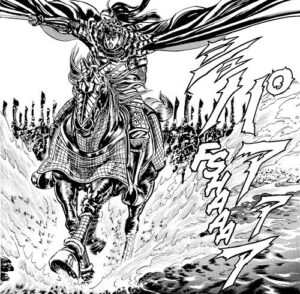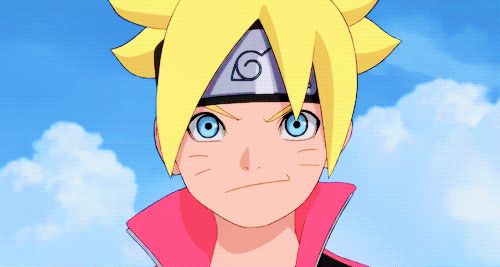The ninth volume ended with a cliffhanger worthy of Seven Samurai: Keiji recruited deserters and brutes to save children. But, in the tenth volume, are these amateurs any match for the enemy armada?
Tetsuo Hara, hero of the battles

Since the previous volume, Keiji has left the intrigues of the palace to find the civil war on the island of Sado. He comes to settle a civil war between the central power and a rebellious lord. One might think that he is involved in political struggles but, in reality, he comes to support his friend Kanetsugu and help the peasants whose children are held hostage in Kawarada Castle.
This military campaign offers the Tetsuo Hara the opportunity to describe extensive fighting. Both gory and emotionally strong, the cartoonist shows bloody images of a man who loses his blood, but gets up to go into battle. The drawing remains extraordinarily precise and the composition very thoughtful. In one page, Hara launches the attack on Keiji and presents the topography of the battle with small annotations. In his humble preface, Tetsuo Hara is both proud to have captured the spirit of the novel, but constantly adding adventures about Keiji, he fears betraying the original work. We can see, for example, that the cartoonist finds his theme of virility when a battalion wears only a loincloth. We think of ancient Greece with disturbing images: a close-up of the soldiers' buttocks.
Keiji, hero of the peasants

To succeed in the siege of the castle, Keiji leads a whole battalion of peasants, but also a colorful group from the latest adventures. A dwarf accompanies him since the very first volumes, but also giants and local peasants. The Keiji series illustrates the duality between individual and collective. His platoon offers kabuki-mono the opportunity to carry out a collective strategy.However, it acts alone. He leads the way and puts himself in danger to preserve the group. Even though the battle is massive, the reader follows a few other individuals in the midst of the confused mass.
Keiji is a disruptive agent of social order. His army is composed of the worst excluded: peasants, old people and prisoners. Yet on the battlefield, they outperformed nobles and professional soldiers, shocking the generals. Keiji then hijacks the codes of war. He steals all the equipment from his own army because these infantrymen are not worthy of it. For him, honor does not come from rank but from action on the battlefield. He creates a banner, but with humor. A skull surmounted by a flower as if war were the breeding ground of life. War is the place where everyone can rise regardless of their origin. At other times, Keiji respects the hierarchy by asking the commander-in-chief for permission to fight. Seeing a chance for victory, Uesugi agrees to close his eyes. Thus it leaves a temporary freedom without questioning the rules in the long term.
The division between nobles and peasants passes through language. Thanks to an excellent translation, one perceives the opposition between the sustained language of the contemptuous nobles and the sudden vulgarity of those who act. The insult serves to silence and upset the order as well as scatological images.
Still published by Mangetsu, this tenth volume proves that Tetsuo Hara and Keiichirō Ryù still have a lot to say. The reader is first surprised by Keiji's vision of war. It can be an opportunity for the excluded. However, by its cruelty, the conclusion shows that no war is good.
Find on the site the chronicle on the first volume and another story series, The Mandala of Fire.















![[Live Report] Rock En Seine 2024 : 20 ans et toujours aussi passionnés !](https://www.justfocus.fr/wp-content/uploads/2024/11/RES24_JOUR01_LANA-DEL-REY_LOUIS-COMAR-12.jpg)























